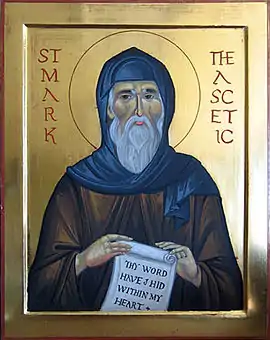Marcus Eremita
Marcus Eremita, Mark the Ascetic or Marcus the Ascetic[n 1] was a Christian theologian, saint, and ascetic writer of the fifth century AD.

Mark is rather an ascetic than a dogmatic writer. He is content to accept dogmas from the Church; his interest is in the spiritual life as it should be led by monks. He is practical rather than mystic, belongs to the Antiochene School and shows himself to be a disciple of John Chrysostom.
Identification
Various theories about his period and works have been advanced. According to Johannes Kunze, Mark the Hermit was superior of a laura at Ancyra; he then as an old man left his monastery and became a hermit, probably in the desert east of Palestine, near Mar Saba. He was a contemporary of Nestorius and died probably before the Council of Chalcedon (451).
Nicephorus Callistus (fourteenth century) says he was a disciple of John Chrysostom.[1] Cardinal Bellarmine[2] thought that this Mark was the monk who prophesied ten more years of life to the Emperor Leo VI in 900. He is refuted by Tillemont.[3]
Another view supported by the Byzantine Menaia[4] identifies him with the Egyptian monk mentioned in Palladius,[5] who lived in the fourth century. The discovery and identification of a work by him against Nestorius by P. Kerameus[6] makes his period certain, as defended by Kunze.
According to a brief entry in the "Great Synaxaristes" of the Orthodox Church, his feast day is observed on May 20.[7]
Works
Mark's works are traditionally the following:
- of the spiritual law,
- Concerning those who think to be justified through works (both ascetic treatises for monks);
- of penitence;
- of baptism;
- To Nicholas on refraining from anger and lust;
- Disputation against a scholar (against appearing to civil courts and on celibacy);
- Consultation of the mind with its own soul (reproaches that he makes Adam, Satan, and other men responsible for his sins instead of himself);
- on fasting and humility;
- on Melchisedek (against people who think that Melchisedek was an apparition of the Word of God).
All the above works are named and described in the "Myrobiblion"[8] and are published in Gallandi's collection. To them must be added:
10. Against the Nestorians (a treatise against that heresy arranged without order).
Of these 8. is now considered spurious.[9]
References
- Andrea Gallandi, Bibliotheca veterum Patrum, VIII (Venice, 1788), 1–104, reprinted with Gallandi's prolegomena in Patrologia Graeca, LXV, 893–1140;
- J. A. Fabricius-G. C. Harles, Bibliotheca graeca, IX (Hamburg, 1804), 267–69;
- Bernard Jungmann-Josef Fessler, Institutiones Patrologiae, II, (Innsbruck, 1892), 143–46;
- Kunze, Marcus Eremita, ein neuer Zeuge fur das altkirchliche Taufbekenntnis (Leipzig, 1896).
- Georges-Matthieu de Durand (1999), Marc le Moine, Traités (two volumes)
Notes
- "Hist. Eccl." in Patrologia Graeca, CXLVI, XlV, 30.
- De Script. eccl. (1631), p. 273.
- Memoires (1705), X, 456 sq.
- Acta Sanct. March 1.
- Historia Lausiaca, XX (P.G., XXXII.
- In his Analekta ierosol. stachyologias (St. Petersburg, 1891), I, pp. 89–113
- (in Greek) Ὁ Ὅσιος Μάρκος ὁ Ἐρημίτης. 20 Μαΐου. ΜΕΓΑΣ ΣΥΝΑΞΑΡΙΣΤΗΣ.
- P.G., CIII, 668 sq.
- Marcus Plested, The Macarian Legacy: The Place of Macarius-Symeon in the Eastern Christian (2004), p. 75.
- also known as Markos Eremites, Marcus the Hermit, Mark the Hermit, Mark the Monk and other similar names.
External links
| Wikiquote has quotations related to: Marcus Eremita |
![]() This article incorporates text from a publication now in the public domain: Herbermann, Charles, ed. (1913). Catholic Encyclopedia. New York: Robert Appleton Company. Missing or empty
This article incorporates text from a publication now in the public domain: Herbermann, Charles, ed. (1913). Catholic Encyclopedia. New York: Robert Appleton Company. Missing or empty |title= (help)